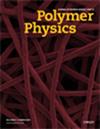星形支链顺式聚异戊二烯的管状膨胀过程
3区 工程技术
Q1 Materials Science
Journal of Polymer Science. Part B, Polymer Physics
Pub Date : 2000-04-15
DOI:10.1002/(SICI)1099-0488(20000415)38:8<1024::AID-POLB3>3.0.CO;2-#
引用次数: 19
摘要
在当前的纠缠管模型中,表示拓扑约束的管被认为是随时间移动的。这种管状运动导致约束释放(CR)和动态管状膨胀(DTD), DTD在纠缠星链中具有重要意义。在此背景下,本文对星链DTD分子图谱的有效性进行了验证。对于各自臂上具有非倒a型(平行)偶极子的单分散星链,如果管在星弛豫的时间尺度上实际膨胀,则归一化粘弹性和介电弛豫函数μ(t)和Φ(t)服从μ(t) = [Φ(t)]2。对于6臂星形顺式聚异戊二烯(PI)链(具有a型偶极子),进行了介电和粘弹性测量来测试这种DTD关系。粘弹性和介电性能均表现出DTD模型所期望的特征行为(假设臂在膨胀管中收缩),松弛时间呈指数增长,松弛模式分布随着臂分子量Ma的增加而展宽。然而,在Ma范围内,Ma≤8Me (Me =纠缠间距),上述DTD关系对于大部分慢弛豫不成立(模型在这个意义上失败了)。因此,对于至少在这个Ma范围内的星链,简单的DTD图假设非常快速的CR运动(膨胀管中的快速平衡)并不能解释星链的缓慢弛豫行为。这一结果反过来表明了CR运动在这种行为中的重要性。©2000 John Wiley & Sons, Inc[J] .高分子材料学报,2003,19 (3):559 - 564本文章由计算机程序翻译,如有差异,请以英文原文为准。
Tube dilation process in star-branched cis-polyisoprenes
In current tube models for entanglement, the tube representing the topological constraint is considered to move with time. This tube motion results in the constraint release (CR) as well as the dynamic tube dilation (DTD), and an importance of DTD has been argued for entangled star chains. Under these backgrounds, this article examines the validity of the DTD molecular picture for the star chains. For monodisperse star chains having noninverted type-A (parallel) dipoles in respective arms, the normalized viscoelastic and dielectric relaxation functions μ(t) and Φ(t) were found to obey a relationship μ(t) ≅ [Φ(t)]2 if the tube actually dilates in the time scale of the star relaxation. For 6-arm star cis-polyisoprene (PI) chains (having those type-A dipoles), dielectric and viscoelastic measurements were conducted to test this DTD relationship. Both viscoelastic and dielectric properties exhibited characteristic behavior expected from DTD models (assuming the arm retraction in the dilating tube), the exponential increase of the relaxation time and broadening of the relaxation mode distribution with increasing arm molecular weight Ma. However, in the range of Ma examined, Ma ≤ 8Me (Me = entanglement spacing), the above DTD relationship was not valid for a dominant part of the slow relaxation (and the models failed in this sense). Thus, for star chains at least in this range of Ma, the simple DTD picture assuming very rapid CR motion (rapid equilibration in the dilated tube) did not explain the slow relaxation behavior of star chains. This result in turn suggested the importance of the CR motion in this behavior. © 2000 John Wiley & Sons, Inc. J Polym Sci B: Polym Phys 38: 1024–1036, 2000
求助全文
通过发布文献求助,成功后即可免费获取论文全文。
去求助
来源期刊
CiteScore
5.90
自引率
0.00%
发文量
0
审稿时长
2.1 months
期刊介绍:
Since its launch in 1946 by P. M. Doty, H. Mark, and C.C. Price, the Journal of Polymer Science has provided a continuous forum for the dissemination of thoroughly peer-reviewed, fundamental, international research into the preparation and properties of macromolecules.
From January 2020, the Journal of Polymer Science, Part A: Polymer Chemistry and Journal of Polymer Science, Part B: Polymer Physics will be published as one journal, the Journal of Polymer Science. The merged journal will reflect the nature of today''s polymer science research, with physics and chemistry of polymer systems at the heart of the scope.
You can continue looking forward to an exciting mix of comprehensive reviews, visionary insights, high-impact communications, and full papers that represent the rapid multidisciplinary developments in polymer science.
Our editorial team consists of a mix of well-known academic editors and full-time professional editors who ensure fast, professional peer review of your contribution. After publication, our team will work to ensure that your paper receives the recognition it deserves by your peers and the broader scientific community.

 求助内容:
求助内容: 应助结果提醒方式:
应助结果提醒方式:


